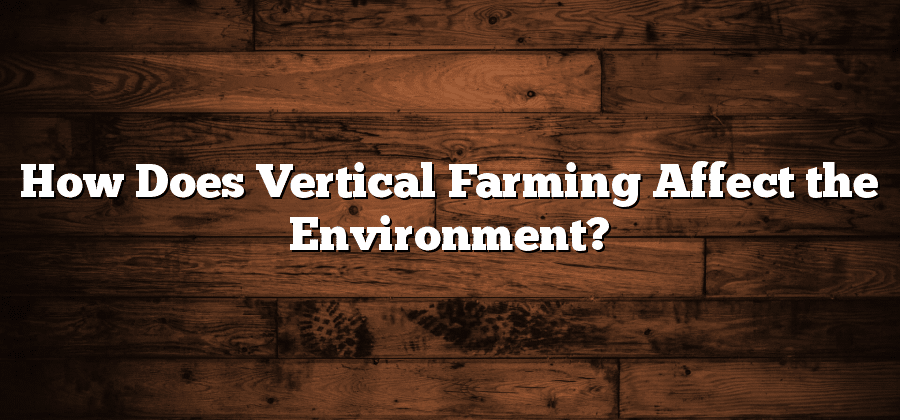The Environmental Impact of Vertical Farming
Vertical farming has emerged as a sustainable solution to the pressing environmental challenges we face today. By utilizing space-efficient methods, vertical farms are able to produce a substantial amount of food in urban areas. This reduces the need for extensive land use, allowing for the preservation of natural habitats and the protection of biodiversity. Additionally, the controlled indoor environment of vertical farms minimizes the usage of pesticides and herbicides, contributing to a healthier ecosystem.
A key benefit of vertical farming is its reduced water usage. Traditional agriculture typically requires extensive irrigation, leading to excessive water consumption and depletion of water resources. In contrast, vertical farms employ innovative techniques such as hydroponics and aeroponics, which use up to 90% less water than conventional farming methods. This not only helps to conserve water but also mitigates the strain on local watersheds and ensures the availability of water for other essential purposes. The environmental impact of vertical farming extends to protecting our precious water resources for future generations.
Resource Conservation in Vertical Farming Practices
Vertical farming practices have gained significant attention in recent years for their potential to conserve resources. One of the key aspects of resource conservation in vertical farming is the efficient use of water. Unlike traditional agricultural practices that require massive amounts of water for irrigation purposes, vertical farms utilize advanced irrigation systems that employ precise amounts of water directly to the plants. Through this targeted approach, vertical farming reduces water wastage and ensures that every drop is utilized effectively. This not only helps in conserving water resources but also minimizes the strain on local water supplies, which is especially crucial in regions facing water scarcity.
Another notable aspect of resource conservation in vertical farming is the reduced need for land compared to conventional farming methods. Traditional agriculture demands vast expanses of land, often leading to deforestation and degradation of natural habitats. In contrast, vertical farms maximize space utilization by growing crops in vertically stacked layers. By harnessing the potential of vertical space, these farms are able to produce a significant quantity of food on a relatively small footprint. This approach helps in preserving natural habitats as there is no need for continuous land clearance, supporting the conservation of biodiversity. Moreover, the reduced land use also opens up opportunities for urban farming, bringing agriculture closer to urban centers and reducing the carbon footprint associated with food transportation.
Reduced Land Use and Preservation of Natural Habitats
Vertical farming offers a promising solution to reduce land use and protect natural habitats. Traditional agriculture requires vast expanses of land for crop cultivation, leading to deforestation and destruction of ecosystems. In contrast, vertical farms utilize vertical space, allowing for greater crop production on a smaller footprint. By stacking crops in vertical layers, these farms maximize land efficiency and reduce the need for widespread land clearing. Consequently, vertical farming can help preserve natural habitats and conserve biodiversity by minimizing human encroachment on fragile ecosystems.
Moreover, the compact nature of vertical farming systems enables cultivation in urban areas, reducing the demand for agricultural land in rural regions. With the global population continuing to grow at an alarming rate, urban sprawl threatens to devour valuable farmland. By implementing vertical farms in urban spaces, we can maintain the integrity of rural landscapes and safeguard fertile land for future generations. Furthermore, this approach promotes sustainable development by minimizing transportation distances between farms and urban markets, thereby reducing greenhouse gas emissions associated with long-haul transportation of produce. The efficient use of land in vertical farming not only conserves natural habitats but also helps mitigate the negative environmental impact associated with agricultural activities.
Mitigating Water Usage and Protecting Water Resources
Water conservation is a critical aspect of any agricultural practice, and vertical farming offers innovative solutions to mitigate water usage and protect precious water resources. With traditional farming methods, excessive amounts of water are often used, leading to water scarcity and unsustainable practices. However, vertical farming utilizes advanced irrigation systems, such as hydroponics or aeroponics, to significantly reduce water consumption.
By using these efficient systems, vertical farms can recycle and reuse water, minimizing waste and ensuring that water resources are utilized responsibly. This closed-loop system allows for precise control over water delivery, providing plants with the exact amount of water needed for optimal growth. Furthermore, vertical farming drastically reduces the risk of water contamination and pollution, as the closed environment prevents the use of harmful pesticides and fertilizers that can leach into water sources.
Moreover, vertical farming techniques minimize water evaporation through controlled environments and precise irrigation methods. The vertical structure of these farms helps reduce surface area exposure to sunlight, which decreases water loss due to evaporation. As a result, less water is needed overall to sustain crops, making vertical farming a sustainable and eco-friendly solution for agriculture. By adopting such practices, we can effectively address the challenges of water scarcity, protect water resources, and achieve a more sustainable future in agriculture.
Energy Efficiency and Carbon Footprint Reduction in Vertical Farming
With increasing concerns about climate change and environmental degradation, the need for sustainable farming practices has become paramount. One such practice that has gained attention in recent years is vertical farming. Not only does vertical farming offer an innovative solution to the global food crisis, but it also presents significant opportunities for energy efficiency and carbon footprint reduction.
One of the key advantages of vertical farming is its ability to utilize space more efficiently compared to traditional farming methods. By stacking crops vertically in controlled environments, vertical farms can produce more food using a fraction of the land area. This reduced land use not only helps conserve natural habitats and biodiversity but also reduces the need for deforestation or conversion of agricultural land. Moreover, vertical farming systems can be integrated into urban settings, reducing the transportation needs and associated carbon emissions from food production and distribution.






